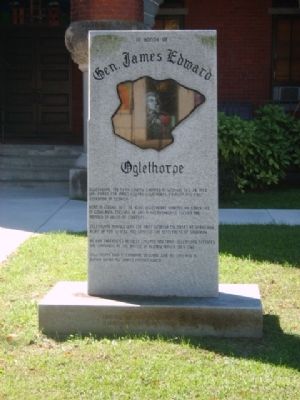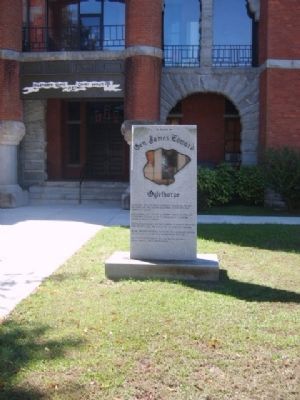Lexington in Oglethorpe County, Georgia — The American South (South Atlantic)
Gen. James Edward Oglethorpe
Oglethorpe, the fifth county created in Georgia, Dec. 19, 1793 was named for James Edward Oglethorpe, founder and first governor of Georgia.
Born in London, Dec. 22, 1696, Oglethorpe started his early life in Godalming, England. He was a philanthropist, soldier and member of house of commons.
Oglethorpe arrived with the first Georgia colonists at Yamacraw Bluff on Feb. 12, 1733, and started the settlement of Savannah. As war threatened between England and Spain, Oglethorpe defeated the Spaniards at the Battle of Bloody Marsh, July 1742.
Oglethorpe died in Cranham, England June 30, 1785 and is buried within All Saints Parish church.
Topics. This historical marker is listed in these topic lists: Cemeteries & Burial Sites • Colonial Era • Settlements & Settlers. A significant historical date for this entry is June 30, 1887.
Location. 33° 52.15′ N, 83° 6.693′ W. Marker is in Lexington, Georgia, in Oglethorpe County. Marker is on West Main Street (State Highway 22), on the right when traveling north. Marker is on the Oglethorpe County Courthouse grounds. Touch for map. Marker is at or near this postal address: 111 West Main Street, Lexington GA 30648, United States of America. Touch for directions.
Other nearby markers. At least 10 other markers are within walking distance of this marker. Oglethorpe County Veterans Monument (a few steps from this marker); James T. Rayle Post No. 123 Monument (a few steps from this marker); Oglethorpe County Confederate Monument (within shouting distance of this marker); Governor Gilmer’s Home (within shouting distance of this marker); Oglethorpe County (within shouting distance of this marker); Historic Oglethorpe County Jail (about 500 feet away, measured in a direct line); Beth-Salem Presbyterian Church (approx. 0.2 miles away); The Birthplace of Columbia Theological Seminary (approx. 0.2 miles away); Meson Academy (approx. 0.2 miles away); a different marker also named Meson Academy (approx. 0.2 miles away). Touch for a list and map of all markers in Lexington.
Also see . . .
1. James Edward Oglethorpe. Wikipedia entry:
James Edward Oglethorpe (22 December 1696 – 30 June 1785) was a British general, Member of Parliament, philanthropist, and founder of the colony of Georgia. (Submitted on October 23, 2014, by Brian Scott of Anderson, South Carolina.)
2. James Edward Oglethorpe. New Georgia Encyclopedia entry:
When he was a boy, James Edward Oglethorpe's oldest brother and father went off to fight in Queen Anne's War (War of Spanish Succession, 1702-1714), never to return. (Submitted on October 23, 2014, by Brian Scott of Anderson, South Carolina.)
3. Battle of Bloody Marsh. Wikipedia entry:
The Battle of Bloody Marsh took place on July 18, 1742 between Spanish and British forces on St. Simons Island, part of the Province of Georgia, resulting in a victory for the British. Part of a much larger conflict known as the War of Jenkins' Ear, the battle was for the British fortifications of Fort Frederica and Fort St. Simons, with the strategic goal the sea routes and inland waters they controlled. (Submitted on October 23, 2014, by Brian Scott of Anderson, South Carolina.)
4. Battle of Bloody Marsh. New Georgia Encyclopedia entry:
On July 7, 1742, English and Spanish forces skirmished on St. Simons Island in an encounter later known as the Battle of Bloody Marsh. Once formal hostilities began in 1739 between the Spanish and English over the land between South Carolina and Florida, shipping on the Atlantic Ocean suffered frequent interruption from acts of piracy by both sides. These skirmishes escalated into the War of Jenkins' Ear and the Battle of Bloody Marsh. This event was the only Spanish attempt to invade Georgia during the War of Jenkins' Ear, and it resulted in a significant English victory. (Submitted on October 23, 2014, by Brian Scott of Anderson, South Carolina.)
5. The Battle of Bloody Marsh - St. Simons Island, Georgia. Explore Southern History entry:
The ferocity of the fighting at Bloody Marsh grew quite a bit in the telling over the years, with the battle taking its name from tradition that the marsh ran red with the blood of dead Spanish soldiers. While this may be true, the actual number of Spanish killed was seven. (Submitted on October 23, 2014, by Brian Scott of Anderson, South Carolina.)
Credits. This page was last revised on February 17, 2021. It was originally submitted on October 23, 2014, by Brian Scott of Anderson, South Carolina. This page has been viewed 469 times since then and 11 times this year. Photos: 1, 2, 3. submitted on October 23, 2014, by Brian Scott of Anderson, South Carolina.


